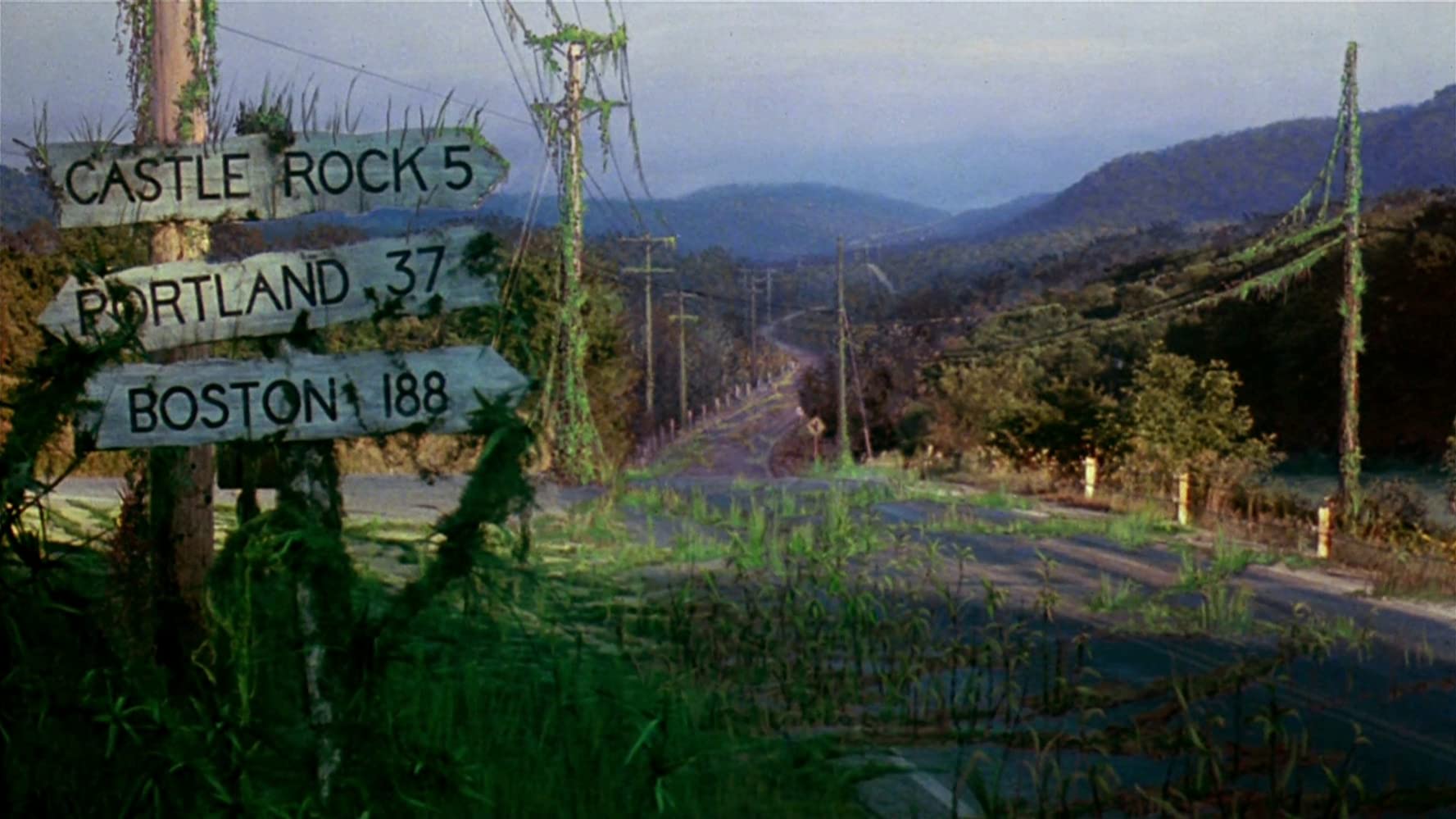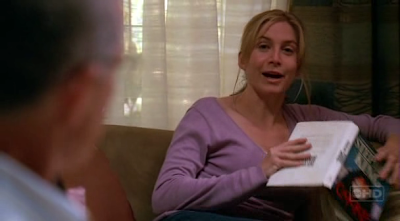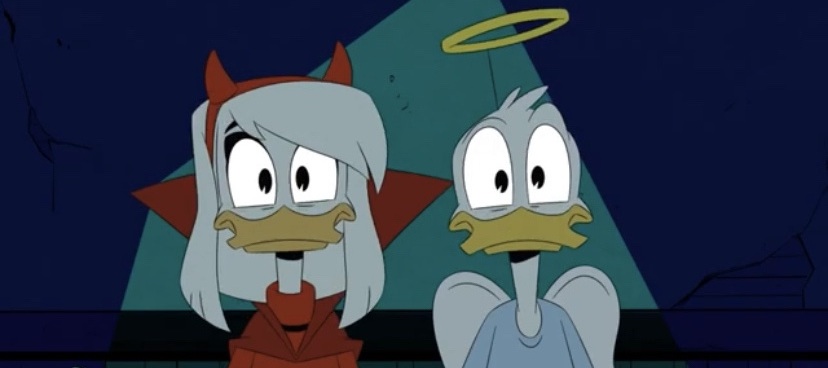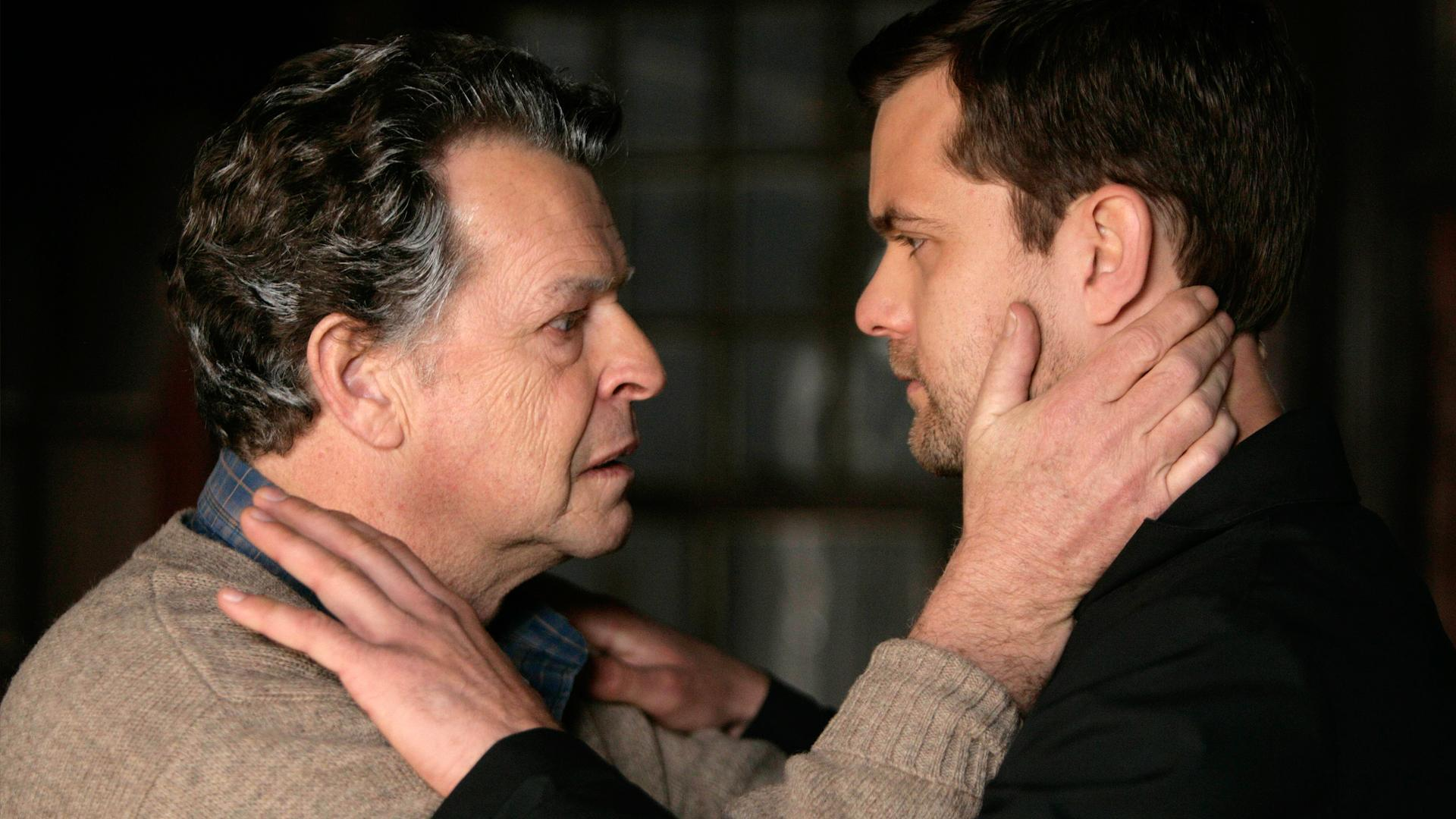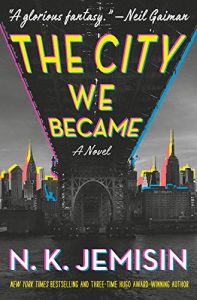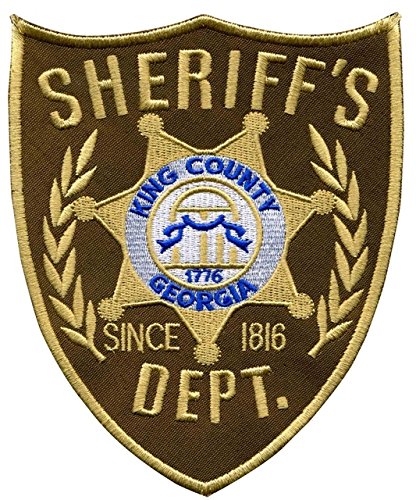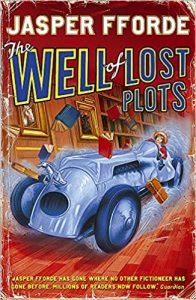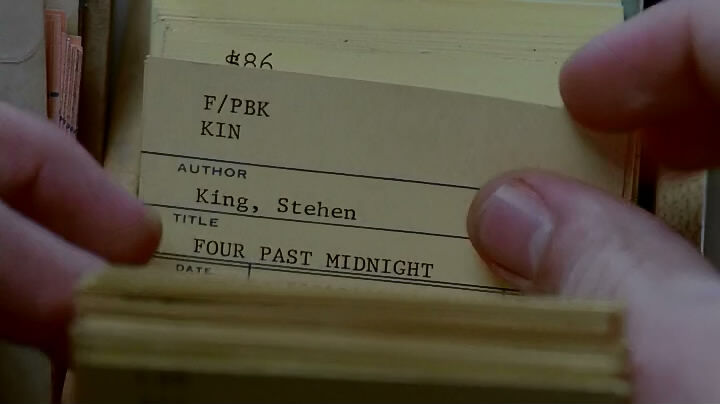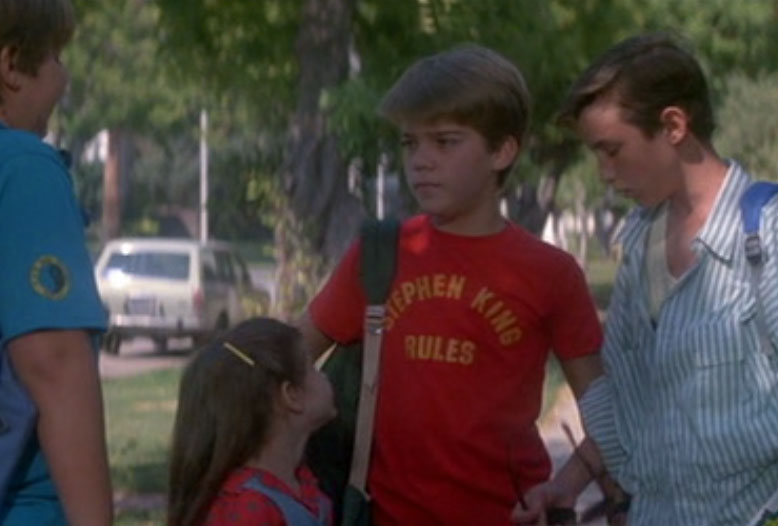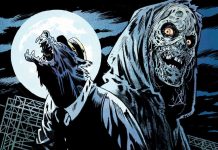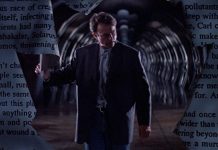In case it wasn’t already obvious, Stephen King’s influence on pop culture is staggering. These nineteen references hardly scratch the surface – in some instances, these entries can’t even cover all the allusions to King that take place in a particular comic, show, book or movie! Be sure and let us know your favorite King references that we missed – say true, and say thankya!
-
Basketful of Heads
King’s son Joe Hill (wait, hold on – King of the Hill! Now I get it!) is no stranger to referencing his father’s work. In Hill’s 2013 novel NOS4A2, a map of the United Inscapes of America even makes a connection between Locke & Key and King’s 1987 novel IT (King returned the favor in his 2013 novel Doctor Sleep, which name checks Charlie Manx, the villain of NOS4A2).
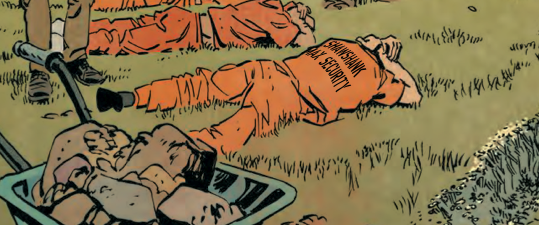
In Basketful of Heads by Hill, Leomacs, Dave Stewart, Deron Bennett, and Reiko Murakami, Maine’s most infamous fictional penitentiary, Shawshank State Prison, makes a cameo in the comic’s first issue.
-
The Simpsons
There are frankly a lot of references to King on The Simpsons, and they aren’t just confined to the annual Treehouse of Horror special (although I would be remiss not to point out that Treehouse of Horror V, the sixth episode of season six, includes “The Shinning,” one of the most best extended King parodies ever – and that’s saying something).
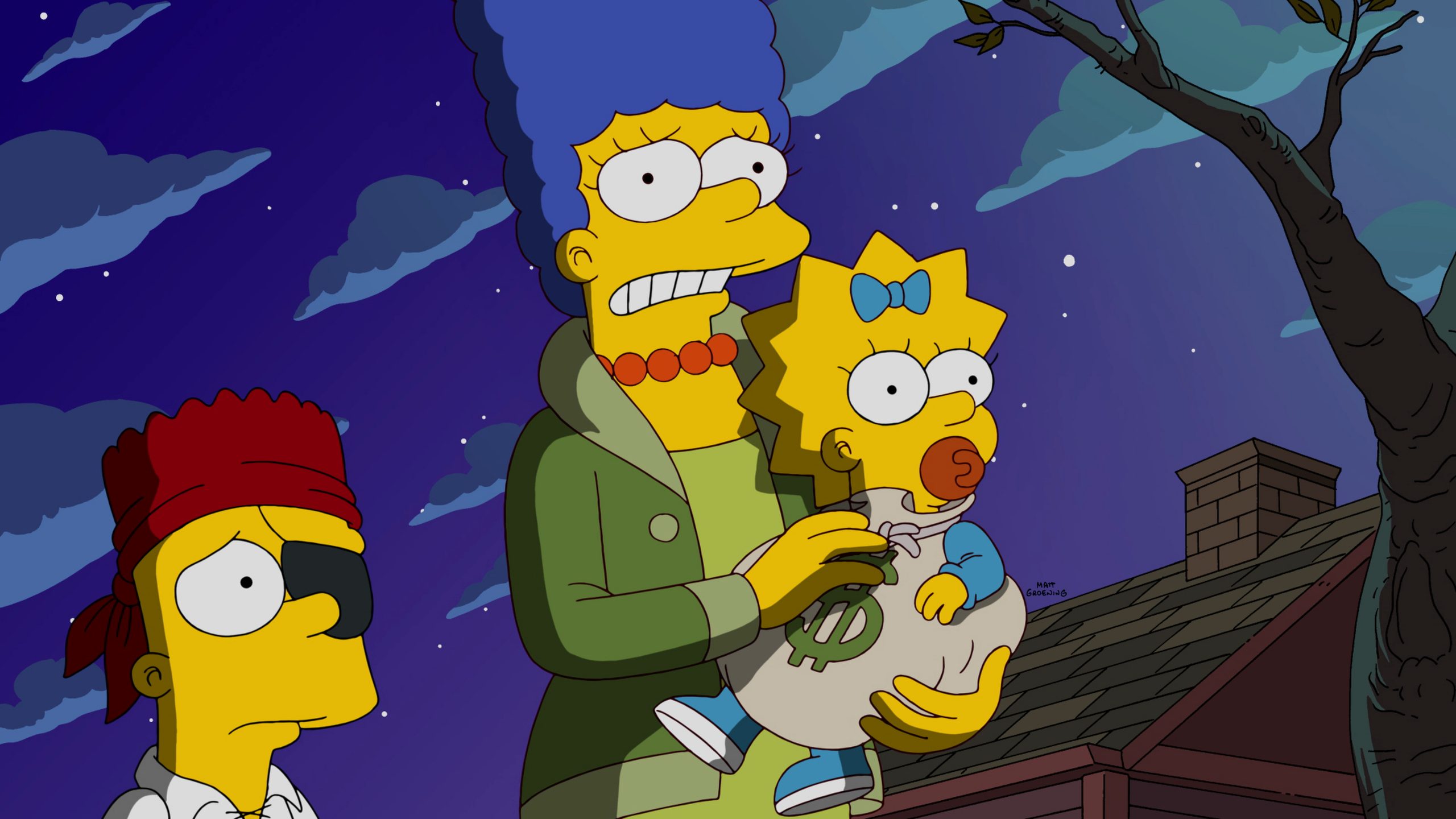
After three decades, we’re all very familiar with the non-canonical Treehouse of Horror format. In the fourth episode of Season 27, “Halloween of Horror,” Matt Groening’s long-running series played with expectations with an “in-continuity” Halloween episode. When Marge, Bart, and Maggie find themselves out past bedtime, they get a glimpse of what the 18+ set does after the younger trick-or-treaters go to bed thanks to the “Time Warp”-inspired musical number, “NC-17 Halloween.” During that song, one of the drunken Springfield adults can be seen wearing a blood-spattered prom dress, a reference to King’s first novel, 1974’s Carrie.
-
Pokémon
In the original Pokémon games for Game Boy, Pokémon Red & Pokémon Blue, released in United States in 1998, the player begins their journey in Pallet Town. Before leaving the house where you’ve lived with your mom, you can check the TV and see a description of a movie that features four boys walking on the railroad tracks.
This is a reference to Stand By Me, based on King’s novella “The Body,” which is included in the 1982 collection Different Seasons. Meanwhile, the Pokémon series has continued to reference Stand By Me, as the reference to the movie on TV reappeared in 2017’s Pokémon Ultra Sun, and an animated reference to the movie even appeared in a recent rock music video celebrating the long-running Nintendo franchise.
-
Creepshow
The big-screen horror screen anthology Creepshow (1982) is in fact the result of collaboration between King and George A. Romero, the cinematic genius behind the Dead cycle. In fact, King even appears on-screen as the eponymous main character of “The Lonesome Death of Jordy Verrill.”
That segment was based on a “Weeds,” a short story by King that was published in Cavalier magazine in 1976. However, while the short story was set in New Hampshire, the Creepshow adaptation relocates the action to Maine – which opens up the opportunity for the final shot of “The Lonesome Death of Jordy Verrill” to include a signpost that reveals Verrill’s infested farm is a scant five miles away from Castle Rock, the setting of many of King’s spine-tingling stories.
Creepshow wasn’t the only time that Romeo’s work paid homage to King (even aside from Romero’s 1993 adaptation of King’s 1989 novel The Dark Half). In 1985’s Day of the Dead, the third movie in Romero’s Dead cycle, Bub the zombie is given several objects to see how he will react – including a copy of King’s 1975 novel Salem’s Lot.
-
LOST
It’s no secret that LOST was heavily influenced by King. According to the season 2 DVD special features, the writer’s room was never without a copy of The Stand. While there were multiple references to King throughout LOST’s six season run, the first episode of the third season, “A Tale of Two Cities,” opened with a particularly memorable allusion.
Juliet Burke (Elizabeth Mitchell) is forced to defend her choice of Carrie for the Others book club. While another member of the group protests that leader Ben Linus (Michael Emerson) wouldn’t read this “by the numbers religious hokum-pokum,” Linus himself doesn’t agree.
A few weeks later, in the fifteenth episode of season two, “Maternity Leave,” Linus is given a copy of The Brothers Karazamov by Fyodor Dostoyevsky, which he responds to by asking for some King to read instead.
-
Afterlife with Archie
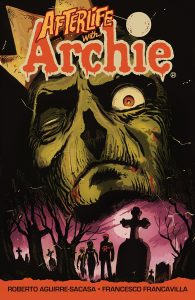
If you think the premise sounds similar to King’s 1983 novel Pet Sematary, you’re not alone – in fact, the first issue of the comic even include dialogue that alludes to one of the most memorable lines from the 1989 big screen adaptation, which it is impossible not to read in Fred Gwynne’s voice: “sometimes dead is better.”
This is far from Aguirre-Sacasa’s only connection to King. In 2009, along with Mike Perkins, Laura Martin, and Chris Eliopoulos, Aguirre-Sacasa worked on the Marvel Comics adaptation of The Stand. And as the showrunner for the ongoing CW series Riverdale, which first began airing in 2017, Aguirre-Sacasa has snuck in a whole Dark Tower’s worth of references to King’s work, from allusions made in dialogue to a whole episode centered on Riverdale high’s performance of Carrie: The Musical (which itself came & went on Broadway in 1988).
-
The Flash
In the twelfth episode of The Flash season one, “Crazy For You,” Clay Parker (Michah Parker) has vanished from prison in spite of a locked cell. As Barry Allen (Grant Gustin) investigates the scene, his father (Tom Cavanagh) makes an appearance and remarks, “Word around here is, Parker pulled a Shawshank.”
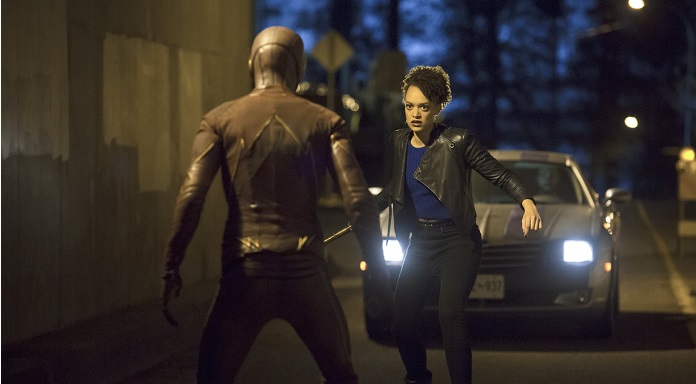
The line is a reference to the novella Rita Hayworth and the Shawshank Redemption, which appears in the 1982 collection Different Seasons (and was adapted to the big screen in 1994). In this case, “Shawshank” is synonymous with “jailbreak,” referring to the climax of the novella.
“Shawshank” isn’t the only slang to emerge from King’s work, either. The title of the 1981 novel Cujo is essentially synonymous with “scary dog,” and the line “All Work and No Play Makes Jack a Dull Boy” from The Shining is often used to allude to the fact that a character is at the end of their rope.
-
The Autumnal
In issue one of The Autumnal by Daniel Kraus, Chris Shehan, Jason Wordie, and Jim Campbell, the story opens with Kat arriving at the principal’s officer at her daughter Sybil’s school, where Sybil is in trouble for fighting with another student.
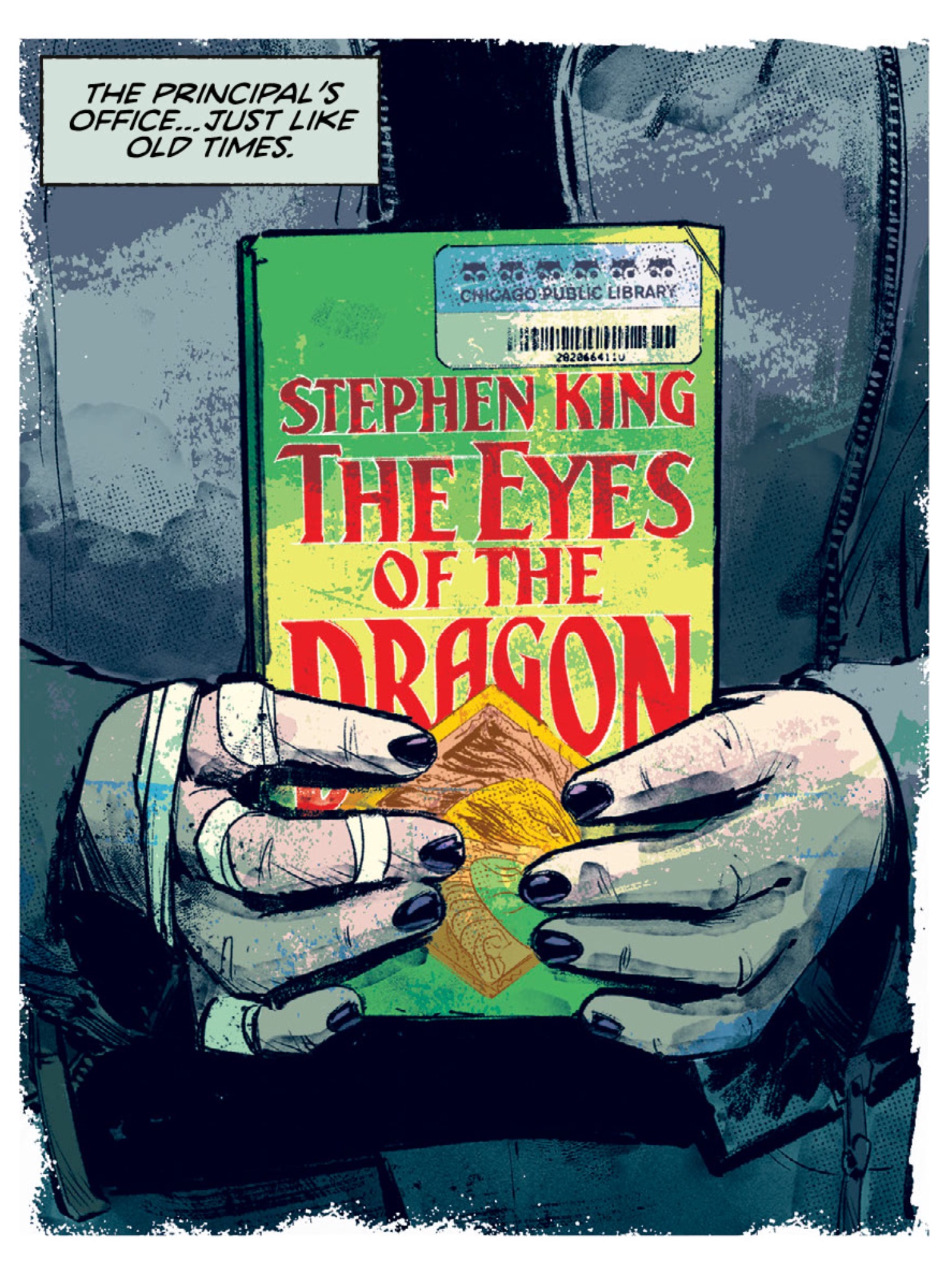
On her way to the school, Kat had her taxi stop by the library so she could check out a copy of King’s 1984 novel The Eyes of the Dragon. The book holds particular significance within King’s oeuvre thanks to the fact that it may just be the earliest in-universe appearance of Flagg, a villain who traipses through dimensions (and different King stories) with the alacrity one would expect from a character nicknamed “The Walkin’ Dude.”
-
DuckTales (2017)
In the tenth episode of the third season of the DuckTales revival, “The Trickening!,” there are multiple references to Stanley Kubrick’s 1980 adaptation of The Shining, King’s 1977 novel about a family stranded at the isolated Overlook Hotel over the winter.
One of the references makes a comparison between identical twin siblings Della and Donald Duck and the Grady twins, the two sisters (played by Lisa and Louise Burns) that memorably menace Danny Torrance from the end of the Overlook hallway. Plus, an additional reference to Kubrick’s infamously King-questioned adaptation of The Shining is simply too funny to spoil.
-
Fringe
In the nineteenth episode of Fringe’s first season, “The Road Not Taken,” Olivia (Anna Torv), Peter (Joshua Jackson), and Walter (John Noble) investigate a series of spontaneous human combustions.
Over the course of the episode, the term “pyrokinesis” is used, which as the characters correctly note was coined by King in his 1981 novel Firestarter. Plus, is it really a coincidence that this was the nineteenth episode of the season?
-
The City We Became
In N.K. Jemisin’s exceptional 2020 novel The City We Became, it’s up to a group of five individuals to defend New York City against The Enemy, a entity from another dimension that often assumes the mundane form of the Woman in White.
Like King’s best work, The City We Became uses the Woman in White to pair supernatural monstrosity with familiar American colonialism, creating a despicable antagonist with one foot in our world and one foot in another. And it seems unlikely that the echoes are coincidental, considering Uncle Stevie himself is name-checked by The City We Became in the very first chapter: when a character collides with a book display in Penn Station, he spills King hardcovers everywhere.
-
The Walking Dead
In The Walking Dead comic by Robert Kirkman, Tony Moore, and Cliff Rathburn, protagonist Rick Grimes begins his journey in the town of Cynthiana, Kentucky. The real-life town is where Kirkman grew up, and a mural that depicts several characters from the series commemorates Cynthiana’s claim-to-fame as the hometown of comic book Rick.
However, for the AMC television adaptation of TWD, which began in 2010, Rick’s hometown was changed to King County, Georgia, a fictional location with a name inspired by Uncle Stevie. Frank Darabont, who developed TWD for AMC and was an executive producer for season one and the first half of the second season of the show, has a personal history with King. Darabont has directed some of the best-received big-screen King adaptations, including The Shawshank Redemption (1994), The Green Mile (1999), and The Mist (2007).
-
The Thursday Next series
In the Thursday Next novels by Jasper Fforde, the realm of fiction is an actual world that can be accessed, either through a technological device called the Prose Portal or through the well-honed abilities of Jurisfiction agents.
However, not all genres are created equal, and horror can prove especially dangerous! Along with Poe, King is cited as a genre that should be entered with extreme caution. Plus, when the realm of fiction is reformed as an island in One of Our Thursdays is Missing, King is significant enough to the genre of Horror to warrant placement on the Fiction Island map (replete with a tiny road sign that reads “Derry”).
-
The X-Files
In the fourteenth episode of season two of The X-Files, “Die Hand Die Verletzt,” there is a subtle reference to King. While searching through the card catalogue in the library at Crowley High School, a card for King’s 1990 novella collection, Four Past Midnight.
It’s far from King’s only involvement with the series – in fact, he would end up co-authoring the script for “Chinga,” the tenth episode of The X-Files season five, with series creator Chris Carter.
-
Sons of Anarchy
In the Sons of Anarchy season three episode “Caregiver,” King himself appears as a “cleaner” named Bachman. Like King, Bachman has a penchant for oldies music.
The character’s name is a reference to King’s pseudonym, Richard Bachman, under which the prolific author published five books between 1977 and 1984: Rage (1977), The Long Walk (1979), Roadwork (1981), The Running Man (1982), and Thinner (1984). Then, in 2007, Blaze, a “lost book” by Bachman, was released, with a foreword written by King.
-
Rick and Morty
In the ninth episode of Rick and Morty’s first season, “Something Ricked This Way Comes,” Summer gets a job at a suspicious store named “Needful Things.” The store sells cursed merchandise to unsuspecting victims, who often find themselves meeting ironic fates as a result.
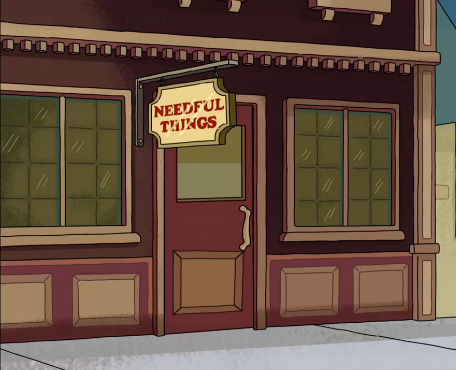
It’s the exact plot of King’s 1991 novel Needful Things, right down to the name of the store.
-
King Country by Jordan Monsell
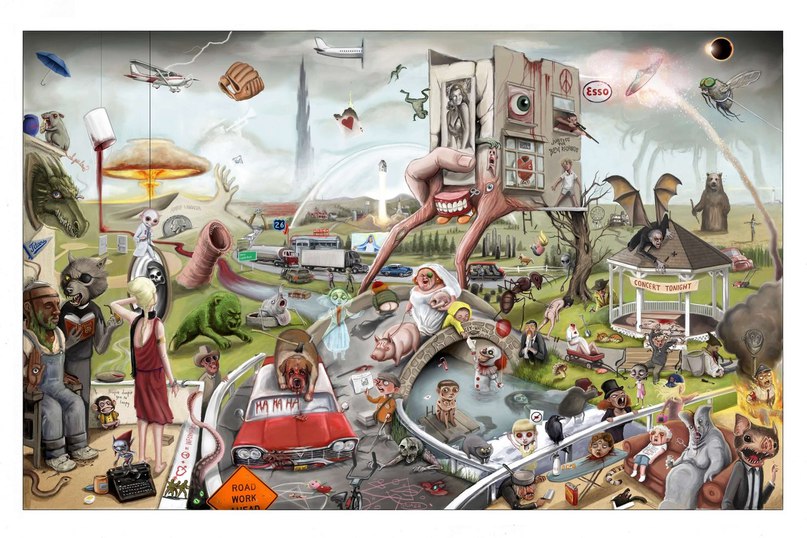
This 2018 illustration by artist Jordan Monsell is entirely comprised of references to King’s oeuvre. Fortunately, Monsell was kind enough to release a key that can help you sort out all the spooky shout-outs:
While Monsell’s online store does not currently sell prints of King Country, it does indeed have some merch that references King’s work – but you’ll have to find that yourself!
-
Monster Squad
In the 1987 movie Monster Squad, a team of classic Universal monsters face off against the Monster Squad, a group of kids who idolize all things spooky – so much so that Sean Crenshaw (played by Andrew Gower) is seen wearing a bright red t-shirt that reads “Stephen King Rules.”
The instantly iconic t-shirt remains popular today – in fact, you can even purchase a COVID-19 defying mask bearing the design. I wonder if it’s effective for Captain Trips, as well?
-
Dolores Claiborne: The Opera
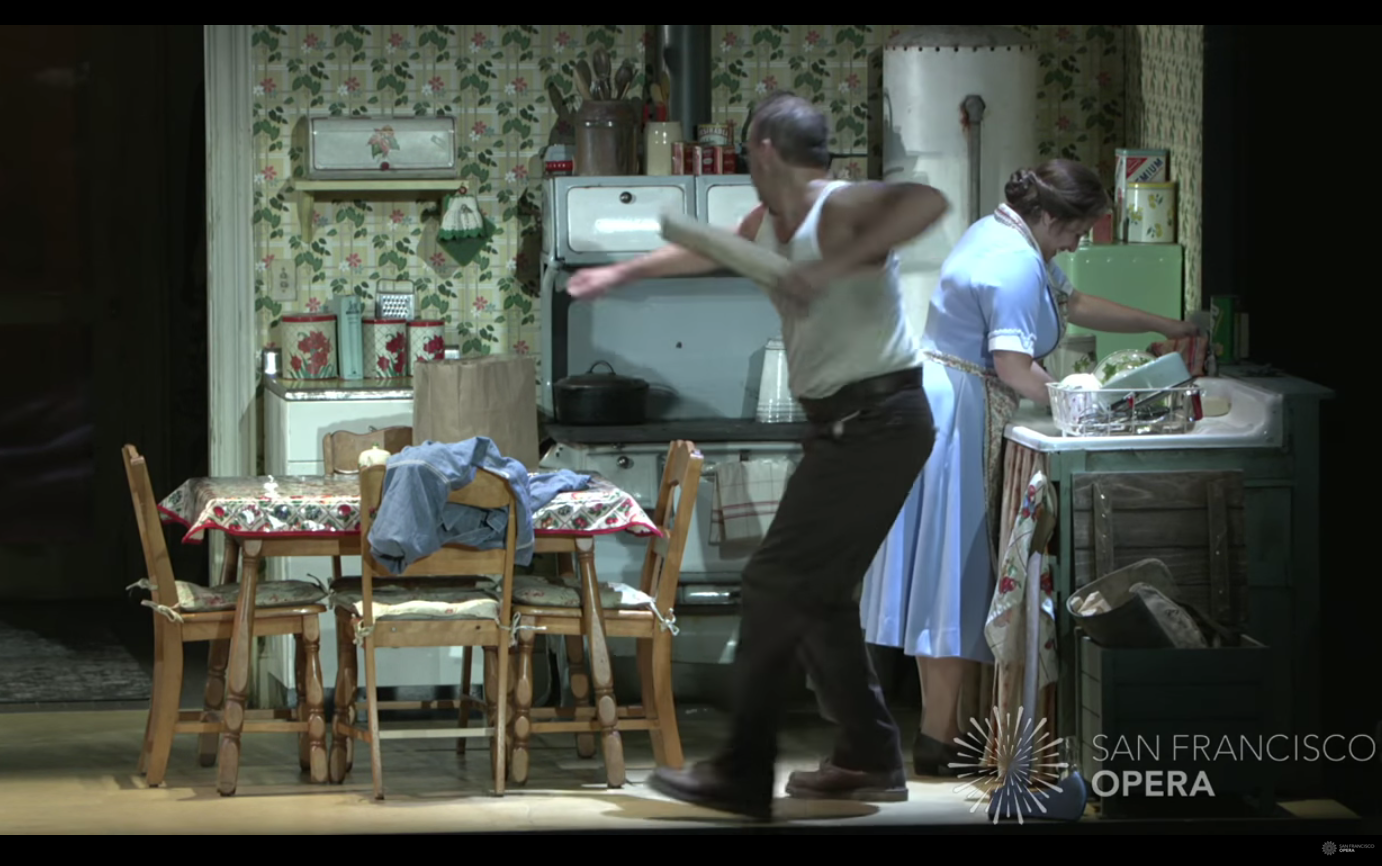
This one’s technically an adaptation rather than an allusion, but it’s simply too good to pass up. In 2013, an opera adaptation of King’s 1993 novel Dolores Claiborne was commissioned by the San Francisco Opera, composed by Tobias Picker with a libretto by J.D. McClatchy.
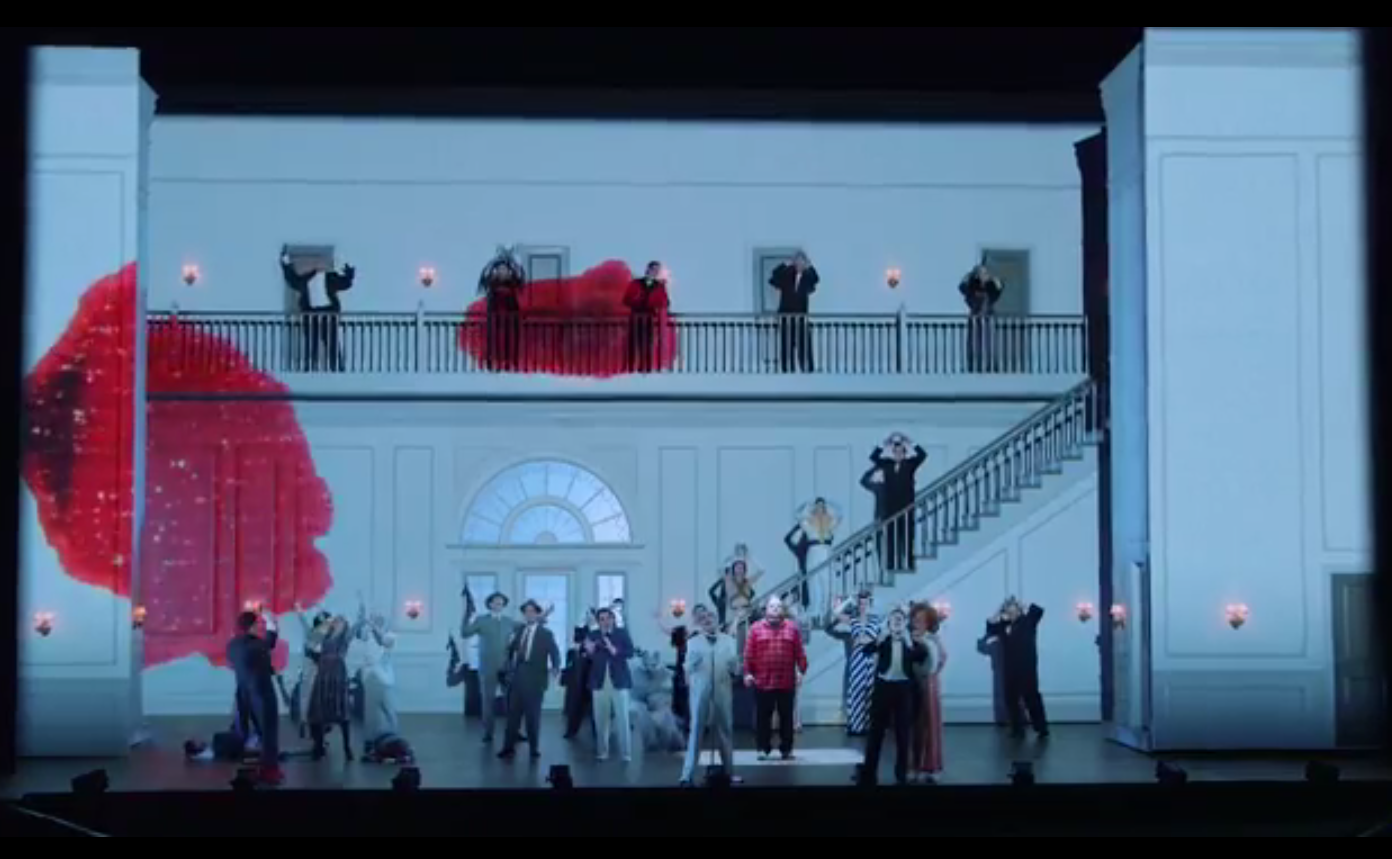
Dolores Claiborne is not the only opera adaptation of King’s work, either. In 2016, the Minnesota Opera debuted The Shining, with a score by Paul Moravec and a libretto by Mark Campbell. King prose purists needn’t fear: The Shining opera is specifically based on the novel, not Kubrick’s big-screen adaptation.




